-
「SpringBoot」07 指标监控
SpringBoot——指标监控
1. SpringBoot Actuator
Ⅰ. 简介
未来每一个微服务在云上部署以后,我们都需要对其进行监控、追踪、审计、控制等。SpringBoot就抽取了Actuator场景,使得我们每个微服务快速引用即可获得生产级别的应用监控、审计等功能。
<dependency> <groupId>org.springframework.bootgroupId> <artifactId>spring-boot-starter-actuatorartifactId> dependency>- 1
- 2
- 3
- 4

Ⅱ. 1.x与2.x的不同
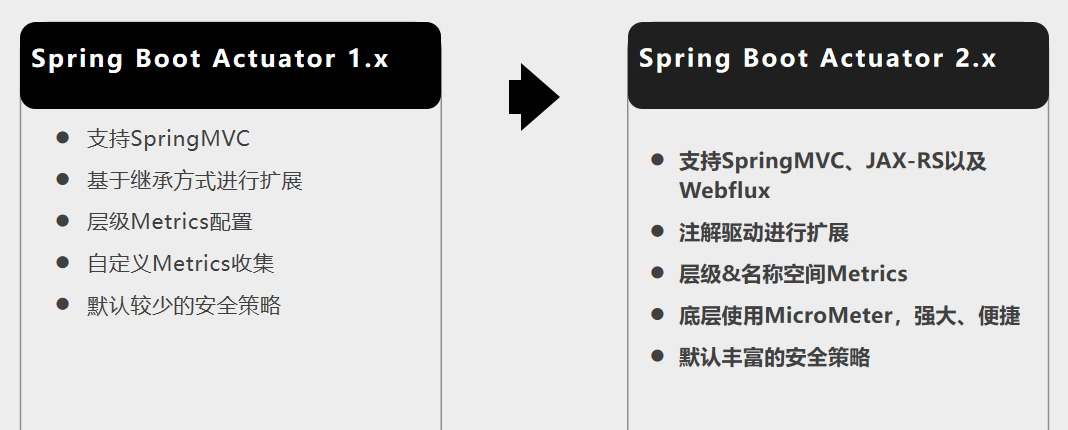
Ⅲ. 如何使用
-
引入场景
-
访问 http://localhost:8080/actuator/**
-
暴露所有监控信息为HTTP
# management是所有actuator的配置 management: endpoints: enabled-by-default: true # 默认开启所有监控端点 web: exposure: include: '*' # 以web方式暴露所有端点- 1
- 2
- 3
- 4
- 5
- 6
- 7
-
测试
➢ http://localhost:8080/actuator/beans
➢ http://localhost:8080/actuator/configprops
➢ http://localhost:8080/actuator/metrics
➢ http://localhost:8080/actuator/metrics/jvm.gc.pause
➢ http://localhost:8080/actuator/ endpointName/detailPath
Ⅳ. 可视化
可视化指标监控
What is Spring Boot Admin?
codecentric’s Spring Boot Admin is a community project to manage and monitor your Spring Boot ® applications. The applications register with our Spring Boot Admin Client (via HTTP) or are discovered using Spring Cloud ® (e.g. Eureka, Consul). The UI is just a Vue.js application on top of the Spring Boot Actuator endpoints.


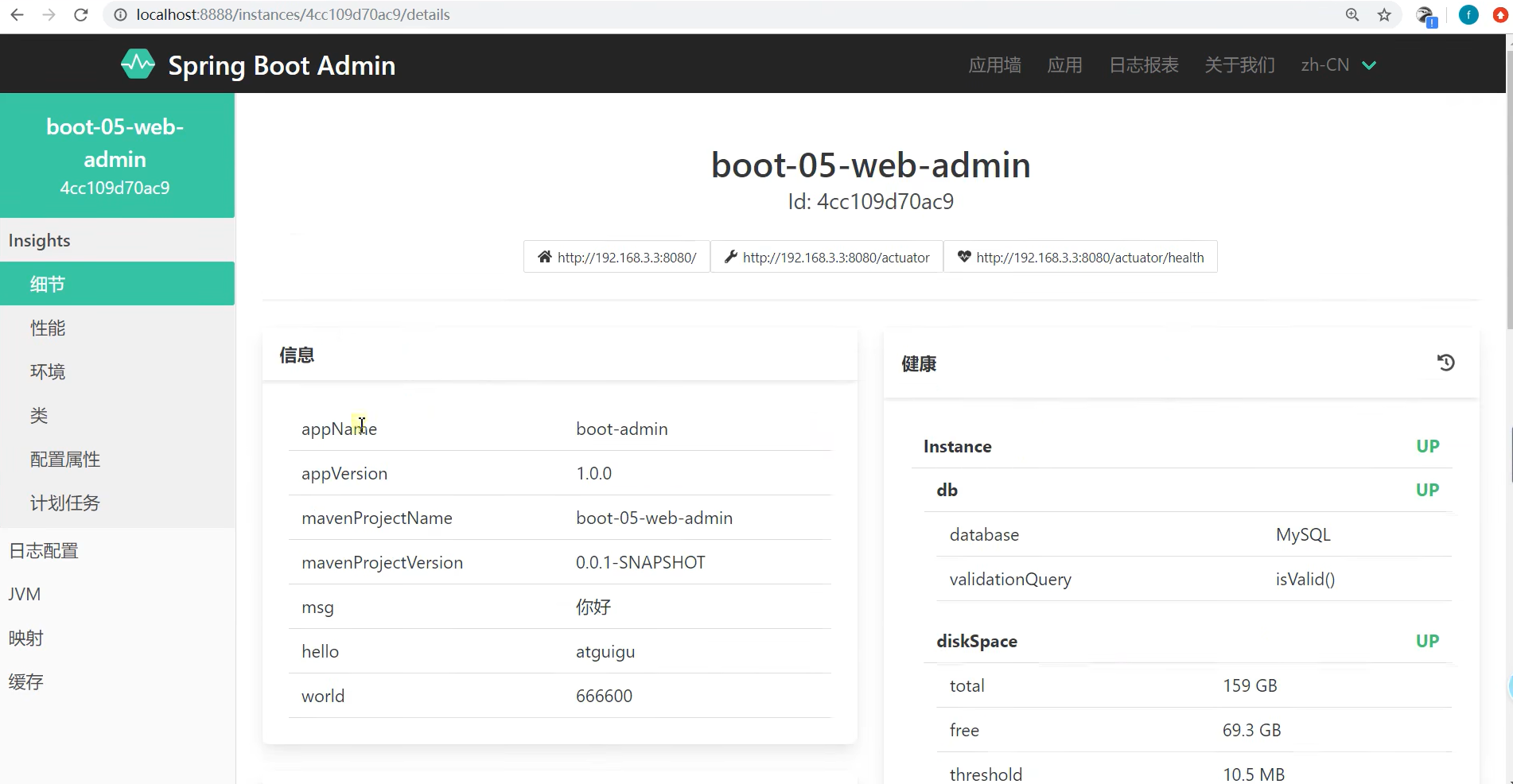
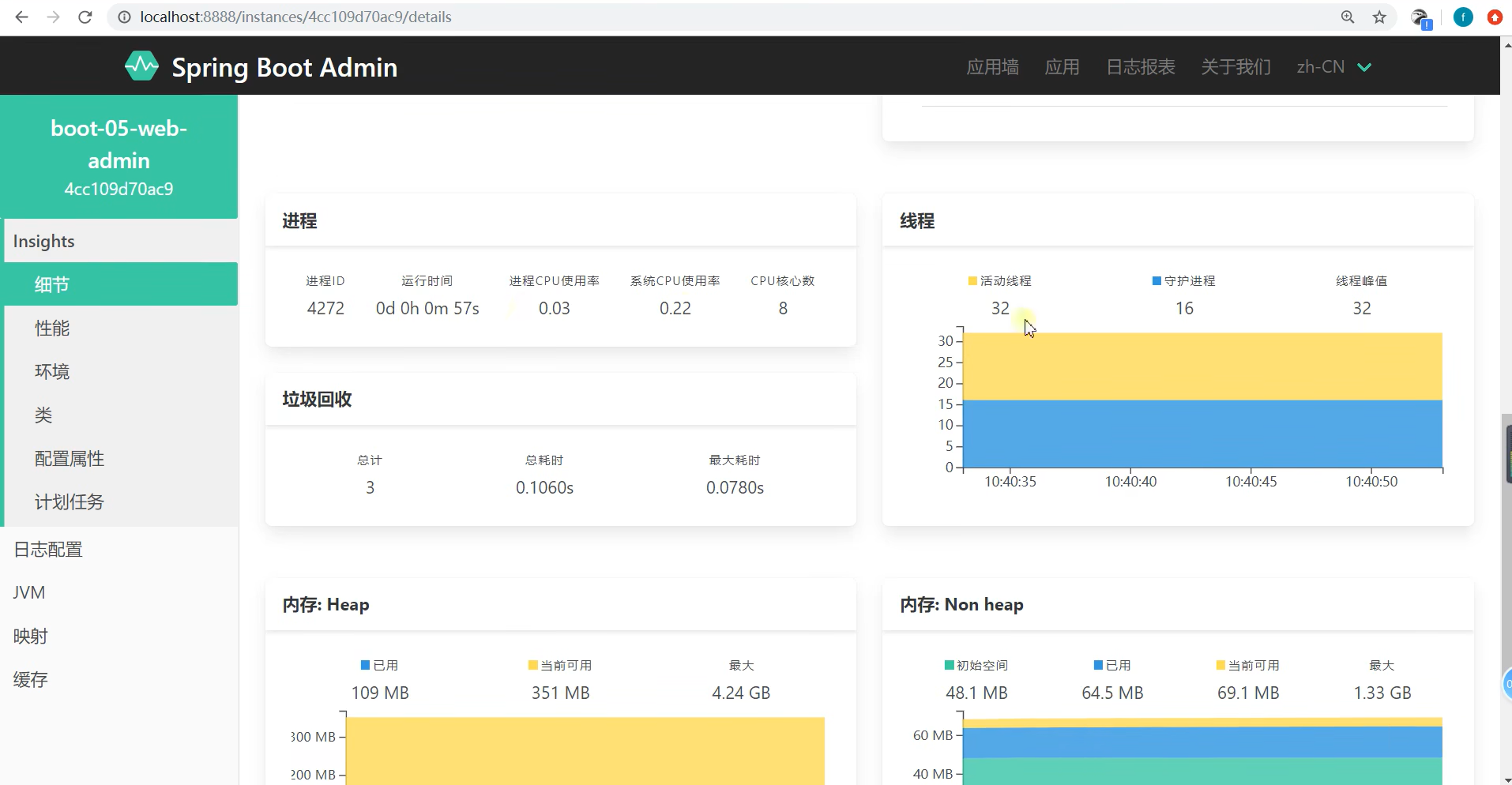




2. Actuator Endpoint
Ⅰ. 最常使用的端点
ID 描述 auditevents暴露当前应用程序的审核事件信息。需要一个 AuditEventRepository组件。beans显示应用程序中所有Spring Bean的完整列表。 caches暴露可用的缓存。 conditions显示自动配置的所有条件信息,包括匹配或不匹配的原因。 configprops显示所有 @ConfigurationProperties。env暴露Spring的属性 ConfigurableEnvironmentflyway显示已应用的所有Flyway数据库迁移。 需要一个或多个 Flyway组件。health显示应用程序运行状况信息。 httptrace显示HTTP跟踪信息(默认情况下,最近100个HTTP请求-响应)。需要一个 HttpTraceRepository组件。info显示应用程序信息。 integrationgraph显示Spring integrationgraph。需要依赖spring-integration-core。loggers显示和修改应用程序中日志的配置。 liquibase显示已应用的所有Liquibase数据库迁移。需要一个或多个 Liquibase组件。metrics显示当前应用程序的“指标”信息。 mappings显示所有 @RequestMapping路径列表。scheduledtasks显示应用程序中的计划任务。 sessions允许从Spring Session支持的会话存储中检索和删除用户会话。需要使用Spring Session的基于Servlet的Web应用程序。 shutdown使应用程序正常关闭。默认禁用。 startup显示由 ApplicationStartup收集的启动步骤数据。需要使用SpringApplication进行配置BufferingApplicationStartup。threaddump执行线程转储。 如果您的应用程序是Web应用程序(Spring MVC,Spring WebFlux或Jersey),则可以使用以下附加端点:
ID 描述 heapdump返回 hprof堆转储文件。jolokia通过HTTP暴露JMX bean(需要引入Jolokia,不适用于WebFlux)。需要引入依赖 jolokia-core。logfile返回日志文件的内容(如果已设置 logging.file.name或logging.file.path属性)。支持使用HTTPRange标头来检索部分日志文件的内容。prometheus以Prometheus服务器可以抓取的格式公开指标。需要依赖 micrometer-registry-prometheus。最常用的Endpoint:
- Health:健康状况
- Metrics:运行时指标
- Loggers:日志记录
Ⅱ. Health Endpoint
健康检查端点,我们一般用于在云平台,平台会定时的检查应用的健康状况,我们就需要Health Endpoint可以为平台返回当前应用的一系列组件健康状况的集合(k8s的自愈机制)。
重要的几点:
-
health endpoint返回的结果,应该是一系列健康检查后的一个汇总报告(所有的组件全健康才算健康)
-
很多的健康检查默认已经自动配置好了,比如:数据库、redis等
-
可以很容易的添加自定义的健康检查机制
# management是所有actuator的配置 # management.endpoint.端点名.xxx 对某个端点的具体配置 management: endpoints: enabled-by-default: true # 默认开启所有监控端点 web: exposure: include: '*' # 以web方式暴露所有端点 endpoint: health: show-details: always- 1
- 2
- 3
- 4
- 5
- 6
- 7
- 8
- 9
- 10
- 11
- 12
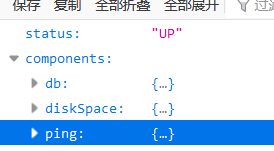
Ⅲ. Metrics Endpoint
提供详细的、层级的、空间指标信息,这些信息可以被 pull (主动推送) 或者 push (被动获取) 方式得到;
-
通过Metrics对接多种监控系统
-
简化核心Metrics开发
-
添加自定义Metrics或者扩展已有Metrics
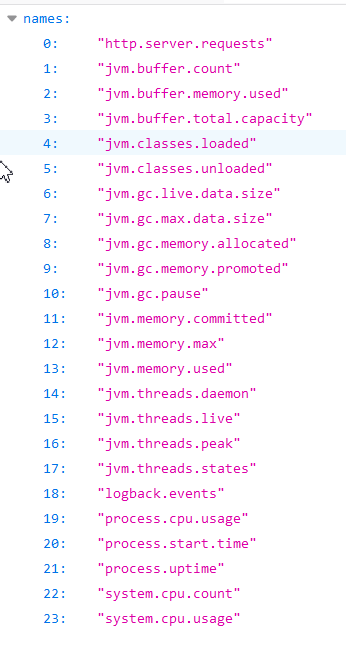
Ⅳ. 管理Endpoints
1️⃣ 开启与禁用Endpoints
-
默认所有的Endpoint除过shutdown都是开启的。
-
需要开启或者禁用某个Endpoint。配置模式为
management.endpoint..enabled = true management: endpoint: beans: enabled: true- 1
- 2
- 3
- 4
-
或者禁用所有的Endpoint然后手动开启指定的Endpoint
management: endpoints: enabled-by-default: false endpoint: beans: enabled: true health: enabled: true- 1
- 2
- 3
- 4
- 5
- 6
- 7
- 8
2️⃣ 暴露Endpoints
支持的暴露方式:
- HTTP:默认只暴露 health 和 info Endpoint
- JMX:默认暴露所有Endpoint
- 除过 health 和 info,剩下的Endpoint都应该进行保护访问;如果引入SpringSecurity,则会默认配置安全访问规则
ID JMX Web auditeventsYes No beansYes No cachesYes No conditionsYes No configpropsYes No envYes No flywayYes No healthYes Yes heapdumpN/A No httptraceYes No infoYes Yes integrationgraphYes No jolokiaN/A No logfileN/A No loggersYes No liquibaseYes No metricsYes No mappingsYes No prometheusN/A No scheduledtasksYes No sessionsYes No shutdownYes No startupYes No threaddumpYes No 3. 定制 Endpoint
Ⅰ. 定制Health信息
实现接口import org.springframework.boot.actuate.health.Health; import org.springframework.boot.actuate.health.HealthIndicator; import org.springframework.stereotype.Component; @Component public class MyHealthIndicator implements HealthIndicator { @Override public Health health() { int errorCode = check(); // perform some specific health check if (errorCode != 0) { return Health.down().withDetail("Error Code", errorCode).build(); } return Health.up().build(); } } // 构建Health Health build = Health.down() .withDetail("msg", "error service") .withDetail("code", "500") .withException(new RuntimeException()) .build();- 1
- 2
- 3
- 4
- 5
- 6
- 7
- 8
- 9
- 10
- 11
- 12
- 13
- 14
- 15
- 16
- 17
- 18
- 19
- 20
- 21
- 22
- 23
management: health: enabled: true show-details: always # 总是显示详细信息。可显示每个模块的状态信息- 1
- 2
- 3
- 4
继承抽象类@Component public class MyComHealthIndicator extends AbstractHealthIndicator { /** * 真实的检查方法 * @param builder * @throws Exception */ @Override protected void doHealthCheck(Health.Builder builder) throws Exception { Map<String,Object> map = new HashMap<>(); // 检查完成 if (1 == 1) { // OUT_OF_SERVICE: 1 == 2 //builder.up(); // 健康 builder.status(Status.UP); map.put("count", 1); map.put("ms", 100); } else { //builder.down(); builder.status(Status.OUT_OF_SERVICE); map.put("err", "连接超时"); map.put("ms", 3000); } builder.withDetail("code", 100) .withDetails(map); } }- 1
- 2
- 3
- 4
- 5
- 6
- 7
- 8
- 9
- 10
- 11
- 12
- 13
- 14
- 15
- 16
- 17
- 18
- 19
- 20
- 21
- 22
- 23
- 24
- 25
- 26
- 27
Ⅱ. 定制info信息
常用两种方式
-
编写配置文件
info: appName: boot-admin version: 2.0.1 mavenProjectName: @project.artifactId@ # 使用@@可以获取maven的pom文件值 mavenProjectVersion: @project.version@- 1
- 2
- 3
- 4
- 5
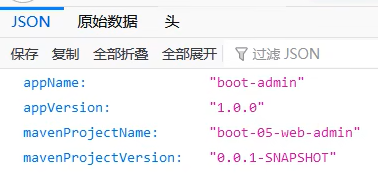
-
编写
InfoContributorimport java.util.Collections; import org.springframework.boot.actuate.info.Info; import org.springframework.boot.actuate.info.InfoContributor; import org.springframework.stereotype.Component; @Component public class ExampleInfoContributor implements InfoContributor { @Override public void contribute(Info.Builder builder) { builder.withDetail("msg", "你好") .withDetail("hello", "atguigu") .withDetails(Collections.singletonMap("world", "666600")) } }- 1
- 2
- 3
- 4
- 5
- 6
- 7
- 8
- 9
- 10
- 11
- 12
- 13
- 14
- 15
- 16
http://localhost:8080/actuator/info 会输出以上方式返回的所有info信息:

Ⅲ. 定制Metrics信息
SpringBoot支持自动适配的Metrics
-
JVM metrics, report utilization of:
➢ Various memory and buffer pools
➢ Statistics related to garbage collection
➢ Threads utilization
➢ Number of classes loaded/unloaded
-
CPU metrics
-
File descriptor metrics
-
Kafka consumer and producer metrics
-
Log4j2 metrics: record the number of events logged to Log4j2 at each level
-
Logback metrics: record the number of events logged to Logback at each level
-
Uptime metrics: report a gauge for uptime and a fixed gauge representing the application’s absolute start time
-
Tomcat metrics (
server.tomcat.mbeanregistry.enabledmust be set totruefor all Tomcat metrics to be registered) -
Spring Integration metrics
增加定制Metrics
class MyService { Counter counter; public MyService(MeterRegistry meterRegistry) { counter = meterRegistry.counter("myservice.method.running.counter"); } public void hello() { counter.increment(); } } // 也可以使用下面的方式 @Bean MeterBinder queueSize(Queue queue) { return (registry) -> Gauge.builder("queueSize", queue::size).register(registry); }- 1
- 2
- 3
- 4
- 5
- 6
- 7
- 8
- 9
- 10
- 11
- 12
- 13
- 14
- 15
- 16
- 17
- 18
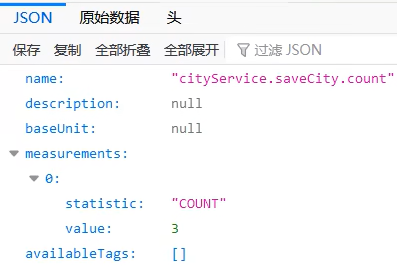
Ⅳ. 定制Endpoint
@Component @Endpoint(id = "container") public class DockerEndpoint { @ReadOperation public Map getDockerInfo() { return Collections.singletonMap("info", "docker started..."); } @WriteOperation private void restartDocker() { System.out.println("docker restarted...."); } }- 1
- 2
- 3
- 4
- 5
- 6
- 7
- 8
- 9
- 10
- 11
- 12
- 13
- 14
场景:开发
ReadinessEndpoint来管理程序是否就绪,或者LivenessEndpoint来管理程序是否存活;当然,这个也可以直接使用 Kubernetes Probes。
-
相关阅读:
网络安全原来有这么多大厂,码住!
重新定义媒体展示形式,头盔屏首现2023重庆摩展
【云原生之k8s】k8s安全机制
mybatis批量插入
C# 托盘通知
职业成功指南:10条核心原则(下)丨三叠云
【Leetcode】134.加油站
fabic.js Quadratic Curve /可控制的曲线
无线投屏冷知识
Real-Time Rendering——8.2.3 Color Grading颜色分级
- 原文地址:https://blog.csdn.net/weixin_53407527/article/details/126023839
